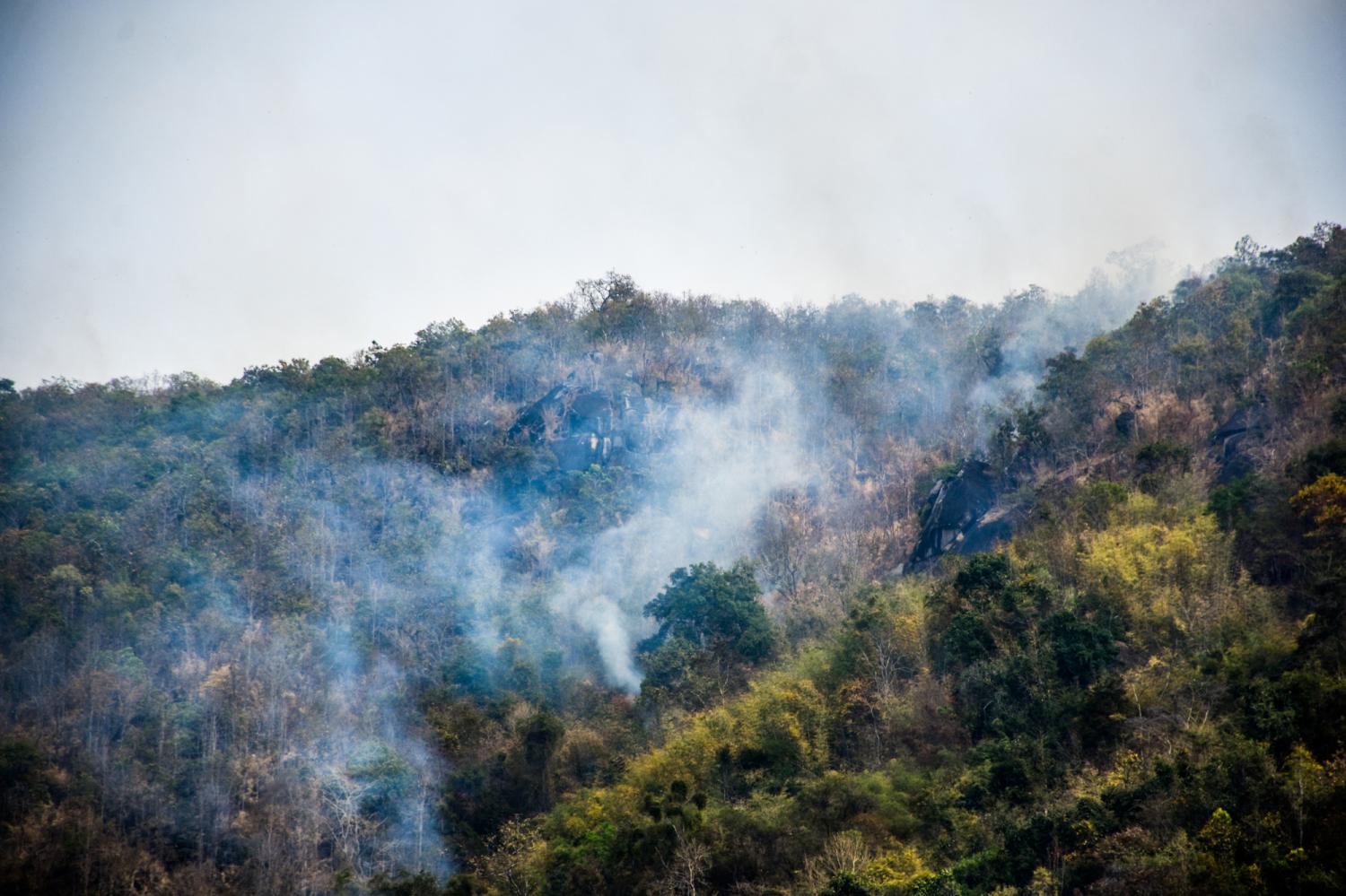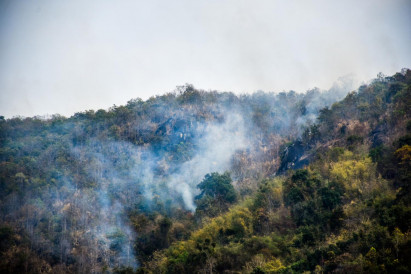
A white mask looked dusty and had turned grey as if it had been left in a dustbin when in fact it had been worn for just one day by a resident in Lampang.
She posted the photo on her Facebook and it went viral on social media last week when the air quality index in the northern province reached 317 and the concentration of fine dust particulate matter (PM) 2.5 in the atmosphere was 207 microgrammes per cubic metre (µg/m³), four times higher than the safe threshold of 50µg/m³.
People expressed concerns over their exposure to air pollution which occurs every year during the dry season, especially January to April. The amount of PM2.5 is intense in many parts of the country, especially 17 provinces in the North and Bangkok, which every year ranks as having some of the world’s worst air pollution.
The Ministry of Public Health says the number of patients suffering from respiratory diseases caused by air pollution is increasing. Early this month it said the number of patients jumped from 163,000 cases in December to 376,000 in January.
According to the World Health Organization (WHO), short-term exposure to high levels of PM2.5 can lead to eye, nose and throat irritation, reduced lung function, respiratory infections and aggravated asthma.
Long-term exposure will increase a person’s risk of diseases such as stroke, heart disease, chronic obstructive pulmonary disease and cancer. People with breathing and heart problems, children and the elderly are particularly sensitive to PM2.5 ultra-fine dust.
”People have a right to live in a clean environment and this is guaranteed under the constitution,” said Penchom Saetang, director of Ecological Alert and Recovery-Thailand (Earth).
She said the air pollution caused by PM2.5 has never been solved. ”It is a hopeless situation if the government has not set clean air policy as the priority,” she said.
The hazardous smog is no longer merely an environmental issue but also a problem concerning public health and the economy, she said.
‘Laws are needed’
According to the Pollution Control Department, the major sources of the annual smog are emissions from the agriculture, transport, and industrial sectors.
Satellite thermal imaging from the Geo-Informatics and Space Technology Development Agency (Gistda) recently detected 2,656 fire-danger hotspots in the kingdom and more in neighbouring countries including Myanmar (2,321), Laos (1,422), Cambodia (664) and Vietnam (542).
In Thailand, most hotspots were in the North: 338 in Lampang, 321 in Tak, 318 in Nan and 249 in Chiang Mai provinces. Out of those 2,656 hotspots, 1,196 hotspots were detected in conservation forests, 1,071 in national forest reserves, 159 in agricultural areas, 127 in areas for agricultural land reform, 100 near communities and three by highways.
Gistda said wildfires and hotspots would be followed by unsafe levels of PM2.5 dust while smoke from hotspots in neighbouring countries could also be blown over the border into Thailand, worsening the PM2.5 problem.
”The next government should regard the issue of haze pollution as its priority policy,” said Ms Penchom of Earth. It should approve at least two bills related to clean air. They are a Clean Air Bill, and the Pollutant Release and Transfer Register (PRTR) bill, which would improve air quality management.
The Clean Air Bill was drafted by the Thailand Clean Air Network (Thailand CAN) which raised 24,000 signatures in its support. The PRTR Bill, meanwhile, is driven by Earth and its alliances such as Greenpeace Southeast Asia and EnLaw.
She said backers of the PRTR bill are collecting signatures. A minimum of 10,000 signatories from Thai nationals is required for the citizen-driven PRTR bill to be submitted to parliament.
She said the country lacked a database for pollutant emissions into the air, water and soil, which means authorities don’t know exactly what the main source of air pollution is.
”The PRTR bill would fix the loophole by forcing industrial operators to report pollutant emissions,” she said.
Policies such as soft loans for helping entrepreneurs access cleaner technology to mitigate greenhouse gas emissions are also needed.
“It is disappointing that the issue of clean air doesn’t exist in politicians’ hearts. Without dedicated action, we despair of seeing better air quality. The politicians don’t realise the problem is really serious,” she said.
Political campaign
Nitipong Piwmow, a party-list MP for the Move Forward Party, said the party is aware of environmental problems, especially the issue of PM2.5.
He said the party supported the Clean Air Bill, but it was rejected by the government. It argued the bill should be considered as a financial bill and as such another process is needed before it could be submitted to parliament.
Mr Nitipong the party has proposed amending the Enhancement and Conservation of the National Environmental Quality Act by giving more power to the Department of Pollution Control. That, too, has yet to be considered by parliament.
He said the Move Forward Party will include the issue of the environment in its campaign pledges, to be announced by the end of this month or early next month.
Challenges ahead
The cabinet on Jan 3 approved measures proposed by the Ministry of Natural Resources and Environment against haze pollution.
They comprise seven-day PM2.5 forecasts on social media platforms, a front-line taskforce to deal with haze pollution, firewood management, hotspot control, crackdowns on pollutant sources, seeking international cooperation on hotspot control and forging participation from stakeholders.
Pinsak Suraswadi, chief of the Department of Pollution Control (DPC), said dealing with haze pollution is a challenging task.
The DPC recently met officers from all 17 provinces in the North to tighten up measures against PM 2.5. Gistda found that in terms of hotspots, 77% are detected in forests, 18% in farming zones and 5% in cities.
He said fast and aggressive actions are needed to end air pollution. These include closer cooperation from neighbouring countries to control transboundary smog.
He said the department would cut its measure of average safe levels of PM 2.5 per day from the current level of 50 µg/m³ to 37.5 µg/m³, which will take effect on June 1 this year.
It is also introducing a fuel based on the EURO 5 standard on Jan 1, 2024, that will help reduce unhealthy pollutants in the atmosphere such as lead and sulphur dioxide.
The Department of National Parks, Wildlife and Plant Conservation and the Department of Royal Forest must tackle forest fires by working closely with provincial governors, he said.
All Ministry of Natural Resources and Environment agencies must support the mission, including updating air quality weekly.
He also advised people to keep tracking air quality via Air4Thai.com. ”Air quality is an urgent issue and needs support from everyone,” he said.

